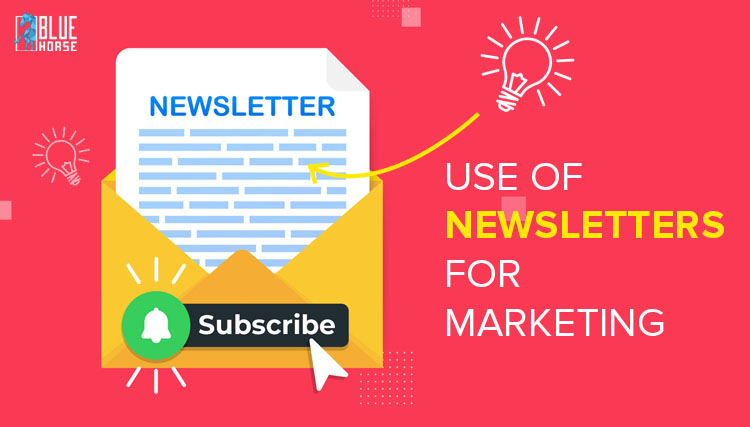USE OF NEWSLETTERS FOR MARKETING
Today, marketers rely on various social networking sites to reach their customers, such as social networking sites, webinars, and video campaigns. But, you should not stop using the old but very effective method - emails.
However, people receive tons of emails from various stores or newsletters to which they subscribe to. So, how can you make sure they open and read your newsletters?

What are email newsletters?
Email newsletters are emails sent to subscribers containing selected information such as recent blogs, product reviews, resources, tips, newsletters, news, and much more. In short, there is no end to what you can include in your newsletters.
The goal is to share important and valuable information with your subscribers, keep them engaged, and promote meaningful relationships. Also, these help to build brand authority and help you better communicate with customers.
You can opt to send your newsletters weekly or monthly.
Why are email newsletters important?
Why do you need to send email newsletters to your customers?
Additional input: The average person checks his or her email 15 times a day or every 37 minutes. In addition, business emails make up the majority (126 billion) of emails sent daily. Therefore, newsletters can give eCommerce brands greater access to their content, products, and services in front of large crowds in a short period.
Increased trust: A newsletter is a great opportunity to highlight your knowledge in a particular field. When you consistently provide relevant, relevant, and personalized content to your subscribers, you increase their trust in your product. Also, rely on your product as a source of information, products, and services.
Personalization: Reaching the right audience increases the likelihood that customers will open and read the content of your magazine. Email marketers can consider their customers' behaviour and preferences to create personalized newsletters and deliver content, products, or services that their subscribers will use extensively. In short, an email newsletter is a way that will help you to meet the needs and expectations of different audiences.
Strong Relationships: Generally, an email newsletter is not considered a marketing strategy but an excellent channel for communicating and bringing value to your customers. When you understand who your customers are, you know their needs and difficulties, and you provide important, relevant information to them that solves their problems, you are more likely to build and strengthen relationships with them.
Newsletters are the best and effective form of email communication with your customers.
As you can see, newsletters are important to your eCommerce business. However, creating and sending newsletters is not enough unless you follow the best practices to be successful.

The best practices for newsletters in marketing
1. Use an attractive title line
2. Personalize your emails
3. Consider the design
4. Organize your emails
5. Follow the adjusted sizes
6. Use email segmentation
7. Find the right email marketing tool
8. Organize your newsletters
Use an attractive eye-catchy topic line
Just because around 47% of customers prefer to receive emails from their favourite products does not mean they will click on every message you send.
The title line is your first impression of the subscribers. It decides that they will open and read your email newsletter. So, make sure it is attractive enough to capture customers' attention.
Consider the following tips for a compelling headline:
Your title will appear differently depending on the device your subscribers are using. Therefore, we recommend keeping it short - about 25-30 characters or 6-10 words.
It should provide an idea of your subscribers' content in the main copy.
Customize your topics by entering a recipient or product name. This makes them feel that a newsletter is specially designed for them.
Always avoid using the word "newsletter".
Use emojis to make the theme lines fun. However, be careful how you use them and how much.
Ask a question on the topic line to generate curiosity among readers.
Personalize your emails
Around 60% of emails are opened on mobiles. A newsletter with a mobile responsive design is no longer an option - you should have it. This means making sure that your newsletter looks good on desktops and mobile screens.
Here's how to organize your emails on mobile devices:
Keep the lines of your theme between 25 to 30 characters to make them look good on mobile screens.
Make sure your copy is short. Divide it into manageable small pieces using points, short sections, etc. This makes it good for your subscribers to read your newsletter, understand your message, and take the action you want.
Not all mobile devices display images automatically. So, use a different text to convey what the image is about. Also, avoid using heavy images to slow downloading time.
Consider the design
Design is the most underrated aspect when creating your email newsletter. Improving design makes your newspaper more attractive and improves its readability, and improves click-through and engagement.
Here's how to design your newsletters properly:
Your email should be short. And it should be easily readable.
Use white space to make news books easier on the eyes.
Use clear and concise CTA buttons. Also, colourful CTA buttons can pop out on the page, making them more visible to readers.
Include your logo, website link, and public profile links to keep your emails on brand.
Use a consistent design of all newsletters so readers can easily see your newsletters from design only.
Use easy-to-read fonts and colours for all different devices. You can use the colours of your product, but not all colours give a good reading experience.
Organize your emails
Next, make sure you provide a clear structure for your newsletters unless you want them to look like informal text blocks. Before you can create your newsletter, you must enter the following sections:
Template: You can choose a pre-designed template provided by your email marketing tool. You can also create an HTML template for the future. Whatever you choose, it looks professional and matches the visual identity of your product.
Design: Your subscribers should quickly see your products with the colours, graphics, and fonts used in your newsletters. Email that is easy to read and well organized can greatly improve your email engagement metrics. In addition, make sure that all visuals are text-based and not professional.
Sender Name: The first thing your subscribers notice and one of the first things spam filters check before allowing email to enter the inbox. Therefore, use trustworthy, easily identifiable, and consistent words in all emails. You can use your brand name to increase awareness. Or use your real name to get a friendly appeal.
Headline: It is one of the most important issues for your newspaper that determines whether a subscriber will open your email or not. If they don't force you enough, they'll just ignore you.
Copy: It is the main part of your newsletter where you disclose a lot of information. Small promotional content combined with high-quality educational content is a great choice.
CTAs: Encourage subscribers to take the action they want, such as visiting a blog, filling out a form, watching a video, etc. You can add CTA buttons and links to the promotional section of your newsletter. Also, do not cover your subscribers with too many CTAs. Instead, use enough to grow relationships.
Unsubscribe Links: Always give your subscribers the option to opt-out of your email list.
Follow the adjusted sizes
Unfortunately, email newsletters do not always have the right size when sending them. The size of the newsletter depends on the device of the subscriber or provider where they open and read their emails.
If the size is wrong, your newsletter will not be visible to your readers and will take longer to load. They will need to scroll right and left to read your emails, significantly reducing click-through rates and resulting in negative user feedback.
Here's how to avoid it:
Stick to a 600-pixel email width as most email providers default to this newsletter size of any device. You can also check and resize depending on your subscribers' screen adjustments and devices.
People are less likely to read your full emails to the end or click to go to your website if the email continues permanently. Therefore, focus on quality rather than quantity.
Avoid using large image files as they take too long to load or may not load. So, keep image sizes between 500 and 700 kb.
Use email segmentation
Many businesses believe that every subscriber should receive the same content. But, if all you give them is general knowledge, there is no chance that they will benefit from it.
If your organization offers a lot of direct positions, it may be wise to divide your readers and create different types of content for each group. It will increase your income by 760% and increase your opening rate to 14.31% and your click rate to 100.95%.
You can differentiate your subscribers based on many factors. The only warning is that this section should allow you to create email and its content, such as demographics, purchase history, unemployed customers, subscription source, interests and preferences, engagement rate, etc., very relevant to that segment of the audience.
For example, you can also send thank giving emails or product recommendation emails to your trusted customers and send first purchase coupons and discounts to new customers.
Find the right email marketing tool
Previously, people used Excel spreadsheets linked to email providers to manage their subscriber lists and send newsletters. However, as email readers increase daily, you need something solid and efficient to simplify the whole process.
Install email marketing tools
With the email marketing tool, you can write, design and send newsletters to a large group of subscribers at once. Also, you can manage your subscribers, evaluate the performance of each magazine, and much more - in one place. These tools are having various features.
Not all marketing services for email are the same. You need to choose one that fits your company's unique needs. Therefore, consider a few factors such as integration, price, features, usability, subscriber limit, etc.
Organize your newsletters
He has created a beautiful newsletter with a compelling headline, a fun copy, and a solid CTA. However, your emails have a low click-through rate. Why? Maybe your time is not right.
People receive tons of emails from different brands, and the top ones get high engagement. Therefore, sending your newsletters on time is important. Timely email can increase your opening and clicking rate, while bad email will lose its value and maybe missed by your readers.
Find the right time to send your email newsletters:
Know your subscribers' time zone. Then send your emails at the right time.
You should find out when your readers check their emails. And which device they use. Do they open their emails during work hours or at night? Do they read newsletters during the week or on weekends?
Make sure you keep track of the miles you have and if and when they expire.
CONCLUSION
Many people believe that you need an email list to send your newsletters.
Of course.
If you have a small list of 15-60 subscribers and expect it to grow to submit your first newsletter, you can't go wrong. Providing relevant content attracts more subscribers. Without you, there is a good chance they will not forget you or remove themselves from your mailing list.
So, whether you have 15 or 1500 subscribers, send your newsletters NOW and keep your customers working with your product while growing your email list.





















Comments